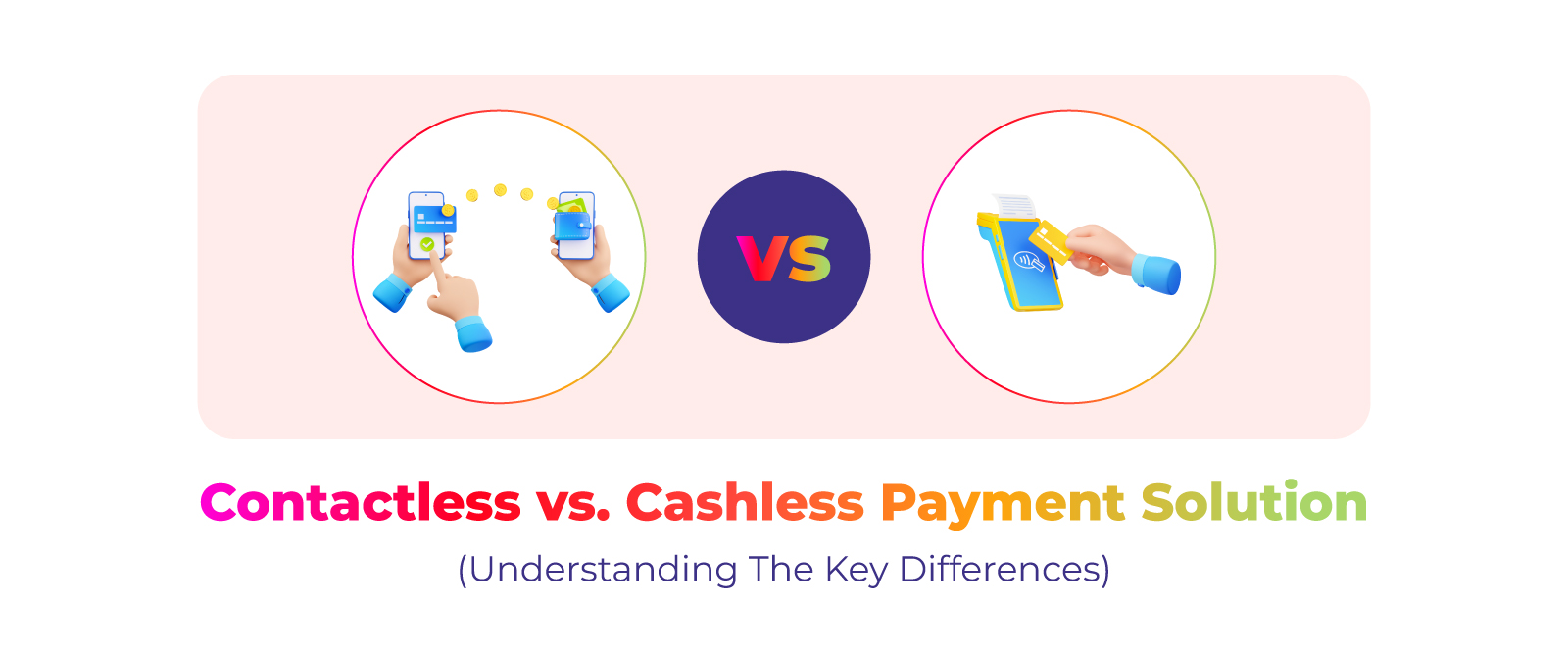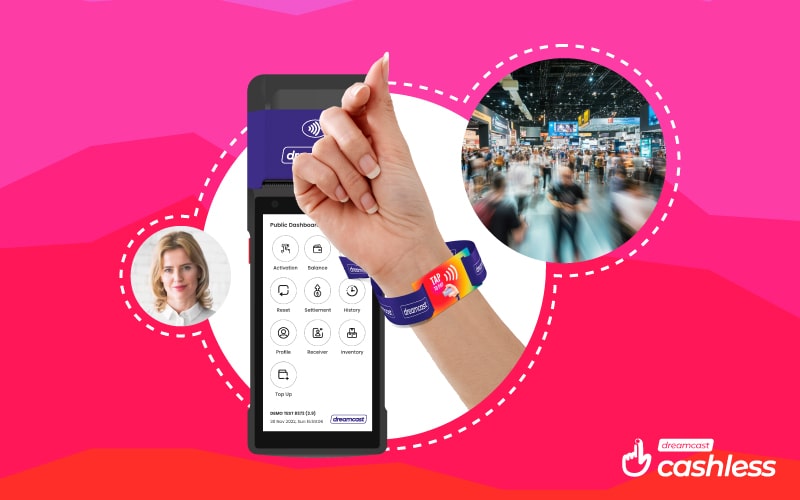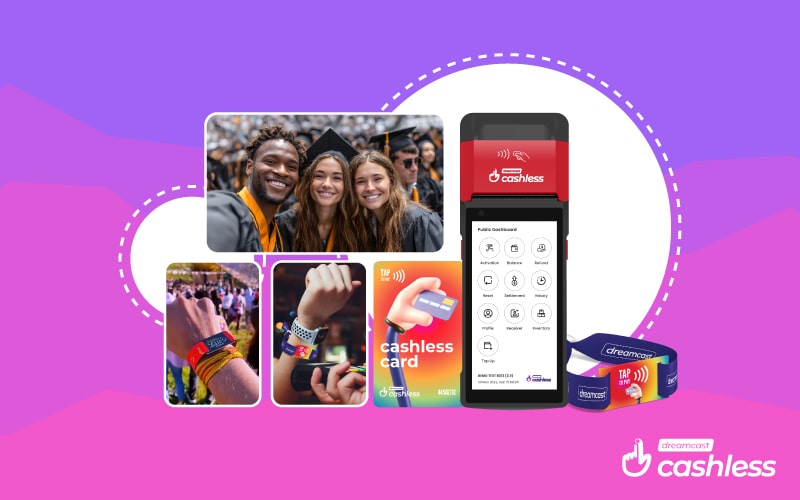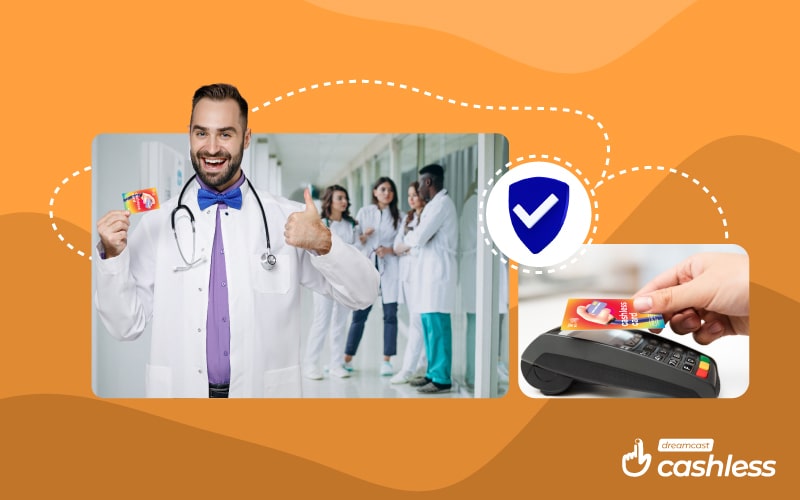Are you confused by the buzz of contactless payments and cashless payment systems? The differences between these two terms must be understood in the continuously changing world of financial transactions. Businesses and customers alike are examining the advantages of quicker payment procedures in light of the development of digital technology. According to the research, the size of the worldwide contactless payment market was estimated at USD 34.55 billion in 2021, and it is anticipated to increase at a CAGR of 19.1% from 2022 to 2030.
In this blog, we will break down the differences between contactless and cashless payment solutions, shedding light on their unique attributes and advantages. Find out which payment option best meets your needs by reading on.
What is a Contactless Payment Solution?
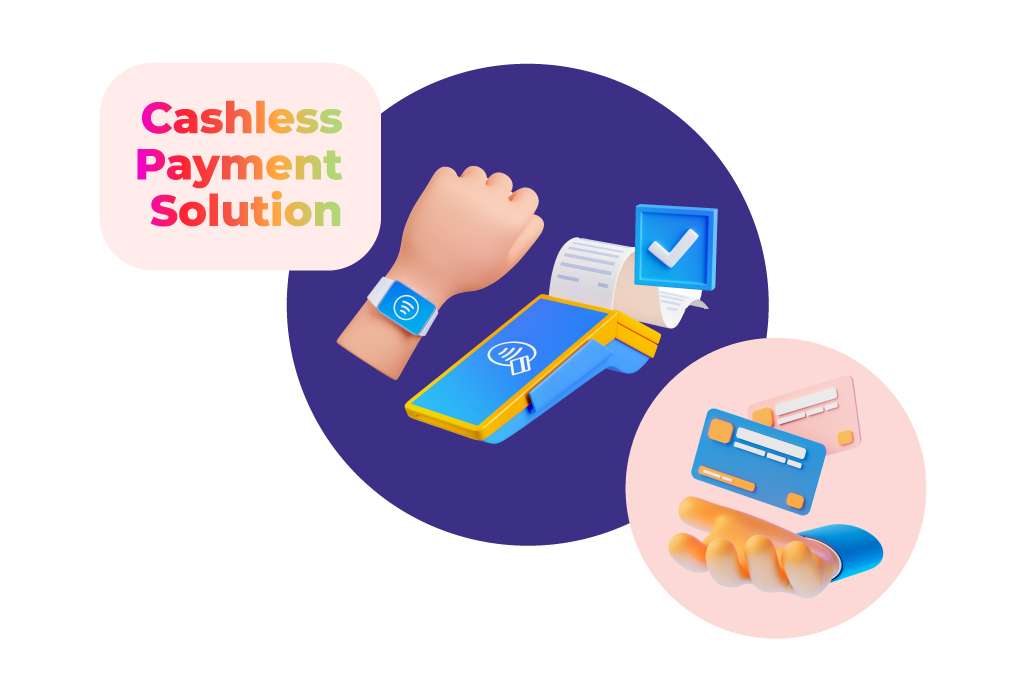
The term “Contactless Payments” describes transactions that may be completed without making physical contact between the point-of-sale (POS) terminal and the payment card or device. This practical payment technique makes use of near-field communication (NFC) technology, which enables data interchange between the card or device and the terminal when they are close together, usually a few millimeters away. Contactless credit/debit cards, mobile wallets (like Apple Pay and Google Pay), and wearable technology like smartwatches and wristbands are just a few examples of contactless payment solutions.
Types of Contactless Payment Solutions
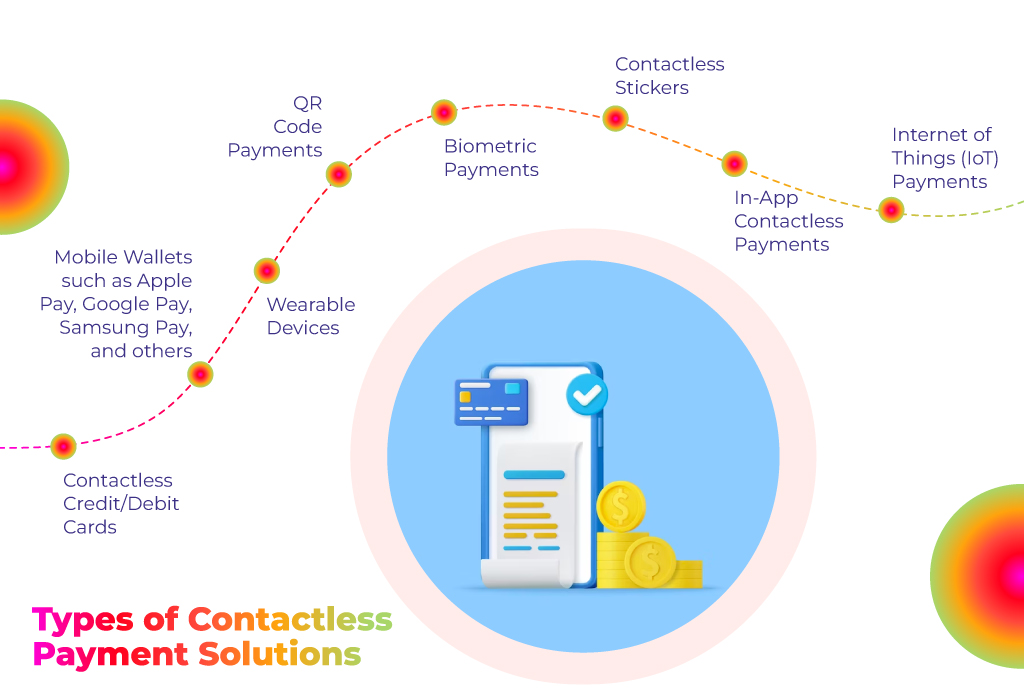
To enable speedy and safe transactions without requiring physical contact between the payment card or device and the point-of-sale (POS) terminal, contactless payments use near-field communication (NFC) technology. Below are some typical contactless payment methods.
- Contactless Credit/Debit Cards
- Mobile Wallets such as Apple Pay, Google Pay, Samsung Pay, and others
- Wearable Devices
- QR Code Payments
- Biometric Payments
- Contactless Stickers
- In-App Contactless Payments
- Internet of Things (IoT) Payments
Benefits of Contactless Payment Solutions
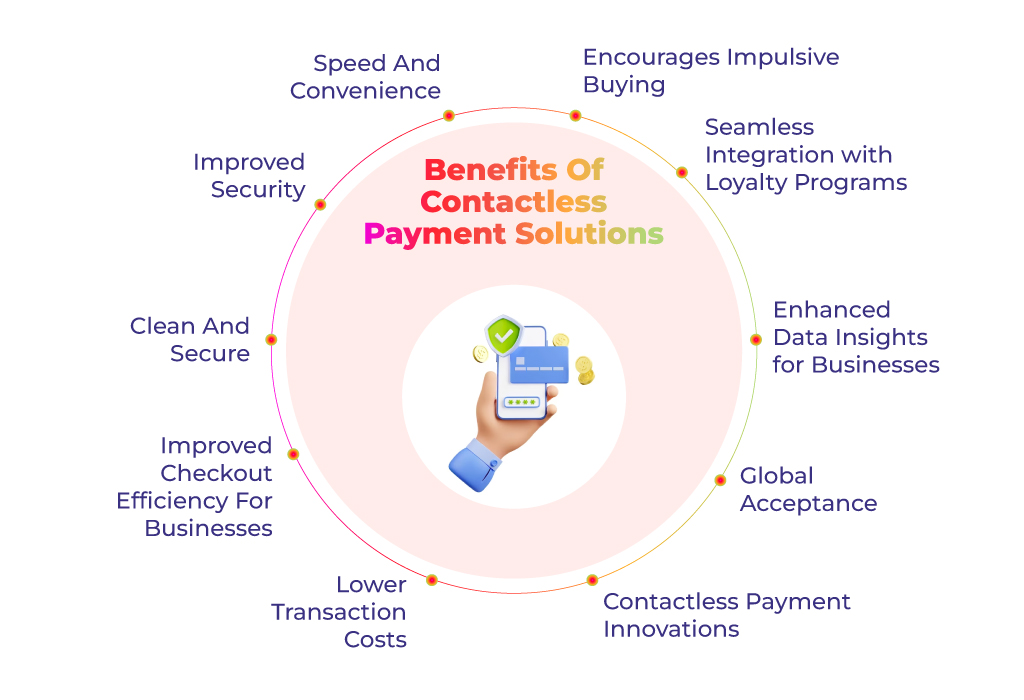
1. Speed and Convenience
The speed of transactions is one of the key benefits of contactless payments. Clients may quickly and easily finish their payment by tapping their card or other device on the POS terminal. This quick procedure shortens lines at the checkout and improves the entire shopping experience.
2. Improved Security
Payments made using contactless payment solutions are very secure. Sensitive data is protected throughout the payment process thanks to the encryption of transactions and tokenization of payment data. Also, since consumers do not provide their cards to cashiers, there is a far lower chance of fraud or card skimming.
3. Clean and secure
Due to its hygienic nature, contactless payments have grown in popularity, particularly in light of current concerns about global health. Clients may pay without contacting the POS device directly, reducing the chance of infection.
4. Improved Checkout Efficiency for Businesses
By speeding up the checkout procedure, contactless payments enable businesses to serve more clients in less time. Queues move more quickly with shorter transaction times, increasing consumer happiness and loyalty.
5. Lower Transaction Costs
Compared to typical cash transactions, contactless payments frequently have reduced transaction costs for companies. Businesses that accept digital payments can cut back on the costs of managing cash, including currency counting, storage, and transportation.
6. Encourages impulsive buying
Contactless payments are quick and simple, which encourages impulsive buying. Without the inconvenience of handling currency or inputting PINs, consumers are more inclined to make quick, low-ticket transactions, which benefits in-person events and enterprises by increasing sales possibilities.
7. Seamless Integration with Loyalty Programs
Many contactless payment methods allow for the direct integration of rewards and loyalty programs. Through this integration, the customer experience is improved as the redemption of rewards points or discounts is made simpler.
8. Enhanced Data Insights for Businesses
Businesses may use the rich transaction data generated by contactless payment systems to get insights into consumer behavior and preferences. Businesses can decide wisely regarding marketing tactics, product lines, and inventory control thanks to these data-driven insights.
9. Global Acceptance
Travelers now have a practical choice thanks to the growing adoption of contactless payments in numerous nations across the world. Without having to worry about currency exchange or carrying a lot of cash, tourists may use their contactless cards or mobile wallets at a variety of venues.
10. Contactless Payment Innovations
Contactless payment solutions now include cutting-edge capabilities thanks to the ongoing development of payment technology. Wearables like rings and bracelets increase the convenience of making contactless payments beyond conventional cards and smartphones, while biometric verification (e.g., fingerprint or face recognition) provides a further degree of protection.

Cons of Contactless Payment Solutions
1. Dependency on Technology
Contactless payments are dependent on technology and connection, much like any other digital payment method. Users might not be able to conduct transactions if there is a technical problem or network outage.
2. Transaction Limits
Users can only make minor transactions using some contactless payment methods without entering a PIN or giving further verification due to transaction restrictions. Larger transactions could find this to be inconvenient.
3. Dependence on Batteries for Mobile Payments
The battery life of the smartphone is important when using mobile payment methods. The user won’t be able to make a contactless payment if the battery runs out until the gadget is recharged.
4. A chance of double-charging
If the payment terminal reads the contactless device twice in some circumstances, an accidental double-charging may take place, causing confusion and inconvenience for the user.
5. Lack of Control over Spending
Quick and simple transactions made possible by contactless payments make it simpler to make impulsive purchases. Overspending and financial distress may result from this.
What is a Cashless Payment Solution?
A simplified explanation of cashless payments is a sort of payment that is done without utilizing currency. Cashless payments include bank transfers, credit card transactions, smartphone payments, and digital wallets, among others. To complete the transaction, the consumer does not need to have any cash on them.
The term “cashless payments” is used in the events industry to refer to a lot more than just payments that are made without using cash. In reality, the use of cashless payment systems such as DC Cashless allows for the creation of a financial ecosystem that does not require the involvement of outside parties. Instead, the data is gathered and stored within the payment system that the buyer and vendor have joined.
Note:- Many cashless payments are also contactless like Apple Pay or QR payments. For instance, inserting a credit card into a card terminal is cashless but is not contactless.
Types of cashless payment solutions
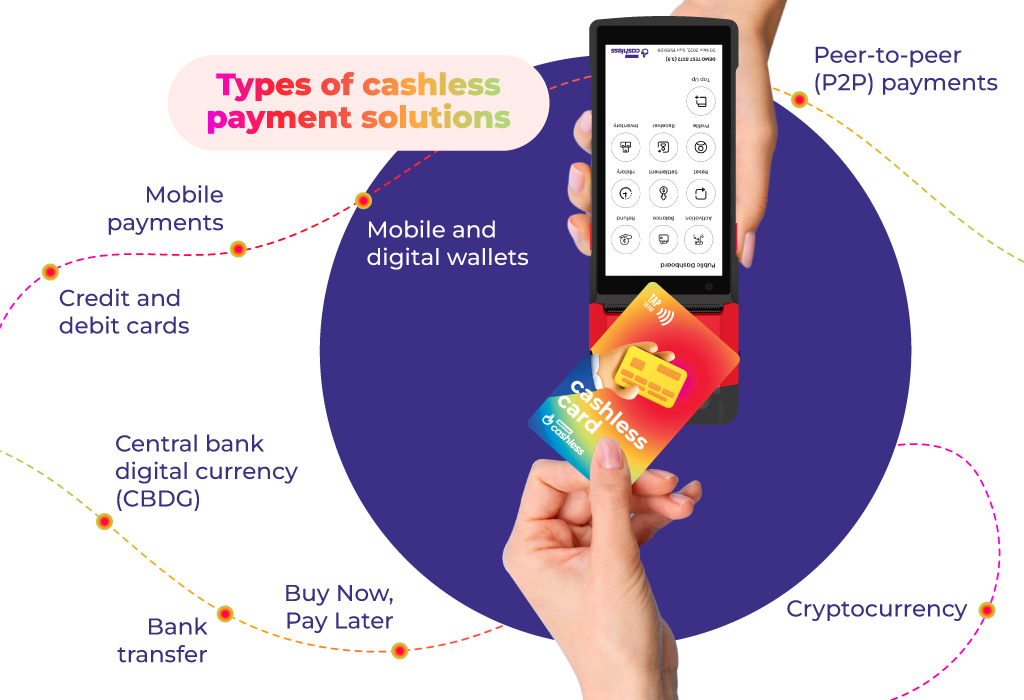
There are different types of cashless payment solutions that you can include in your in-person event or business. Some of them are given below:
- Credit and debit cards
- Mobile payments
- Mobile and digital wallets
- Peer-to-peer (P2P) payments
- Central bank digital currency (CBDG)
- Bank transfer
- Buy Now, Pay Later
- Cryptocurrency
Benefits of Cashless Payment Solution
1. Convenience and Efficiency
Transactions may be completed more quickly and easily using cashless payments. Customers no longer need to touch physical currency, which speeds up checkout times. Instead, payments may be made with a simple tap, swipe, or click.
2. Improved Security
It is one of the best reasons to use cashless payment solutions in the events. To secure sensitive payment information, cashless payment systems use cutting-edge security techniques including encryption, tokenization, and biometric authentication. Thus there is less chance of theft and fraud when carrying cash.
3. Contactless Transactions
Contactless transactions are possible with several cashless payment methods, including mobile wallets and contactless cards. The market for mobile payments is expanding. Between 2023 and 2030, a CAGR of 36.2% is anticipated for growth. Particularly during health emergencies, this function is helpful in improving cleanliness and reducing the transmission of infections.
4. Financial Tracking and Budgeting
Cashless transactions leave a digital trail, allowing consumers to keep track of their spending and manage their budgets more effectively. Users who have access to extensive transaction histories through banking applications or statements can better understand their spending patterns and make wise financial decisions.
5. Ease of Online Shopping
Online buying experiences are made simpler by cashless payment solutions. Users no longer need to enter their credit card information each time they make a purchase thanks to cached payment information.
6. Global Accessibility
Cashless transactions are available to users everywhere since they cross regional boundaries. Its simplicity of use makes international transactions easier, promoting global trade and business.
7. Promotes Financial Inclusion
By giving underserved or unbanked communities access to banking and digital payment services, cashless payment solutions can promote financial inclusion. Those without conventional bank accounts may participate in the digital economy thanks to mobile wallets and other digital payment methods.
8. Reduced Cash Handling Costs for Businesses
By lowering the costs associated with handling cash, such as cash counting, transportation, and security measures, businesses that accept cashless payments can save money.
9. Real-Time Transactions and Instant Settlements
By enabling real-time transactions and immediate settlement, cashless payment systems eliminate the risks and delays involved in handling physical cash.
10. Data-Driven Insights
Cashless payment solutions provide insightful data on customer spending and behavior. Companies may utilize this information to better understand client preferences, improve marketing tactics, and efficiently customize products and services to match customer demands.

Cons of Cashless Payment Solution
1. Dependency on Technology
Systems for cashless payments rely significantly on technology, including electronic devices and internet access. Users may experience any technical issues or system faults.
2. Delays in payments
Due to processing times, cashless transactions may occasionally experience delays, which causes inconvenience for both customers and businesses.
3. Lack of Control over Spending
People frequently have a better understanding of their spending patterns when utilizing cash. Nevertheless, because one-click transactions are so convenient, it’s simpler to lose track of spending and overspend when using cashless payments.
4. Dependency on Financial Institutions
Since cashless transactions are linked to financial institutions, any problems with banks or payment processors may cause disruptions or inconveniences.
5. Regulatory and Legal Challenges
As the use of cashless payment methods expands, regulatory issues involving matters like consumer protection, dispute resolution, and liability in the event of fraud or unauthorized transactions may surface.
Final words:-
In conclusion, both contactless and cashless payment methods have their advantages, and users may choose between them based on their own tastes, the availability of certain technologies, and certain use cases. It is crucial for people and organizations to stay educated and adapt to the shifting financial transaction landscape as digital payment options continue to develop.
Whether you choose the quick and secure tap of contactless payments or the wider range of cashless transactions, implementing these contemporary payment solutions can result in a more effective, secure, and sustainable economic ecosystem. So what are you waiting for? Connect with DC Cashless to remain competitive, improve the customer payment experience, and increase sales.
FAQs
Contactless payment solutions refer to transactions where payment is made by tapping or waving a contactless-enabled card, smartphone, or wearable device near a payment terminal. Cashless payment solutions, on the other hand, encompass a broader range of payment methods that eliminate the need for physical cash.
Comparing contactless and cashless payments to conventional cash transactions, both provide higher levels of security. Tokenization is used in contactless payments to secure card information, and authentication is typically required. To secure user data, cashless transactions like mobile payments and web transfers use encryption and security procedures.
For real-time transaction processing, cashless payment solutions frequently need an internet connection. Nonetheless, certain systems allow for offline transactions, and mobile wallets could be able to locally store a small number of payment credentials.
Cashless payment solutions give event planners more ease, quicker transactions, less cash handling, and enhanced security. Moreover, cashless systems can offer insightful data that can be used to better understand the preferences and behavior of attendees.


